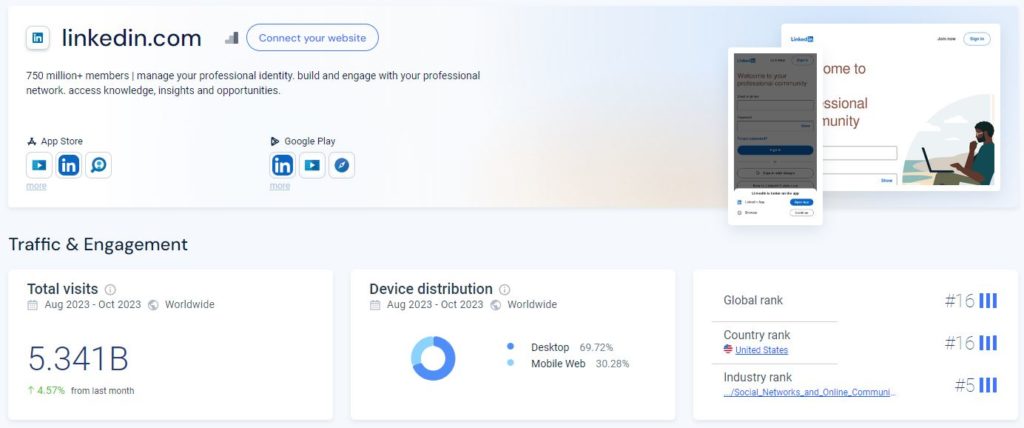
Is LinkedIn Good for SEO?
LinkedIn, founded in 2003, revolutionized professional networking by creating a platform specifically tailored for business professionals. It’s not just a digital resume repository; it’s a dynamic hub where industry insights, thought leadership, and networking opportunities converge. The platform is renowned for its focus on professional content and community, catering to a broad range of sectors and professionals, from entry-level to CEOs.
| Website: | linkedin.com |
| Founded: | 2003 |
| Type of Platform: | Professional networking platform |
| Key Features: | Professional networking, job searching, content sharing, messaging, groups, news feed, endorsements, recommendations, skill endorsements, company pages, career interests, LinkedIn Learning, events, polls, hashtags |
| Content Types: | Test, Video, Images, other multimedia |
| Popular Content: | Professional profiles, job postings, industry news, career-related articles, and updates |
| Target Audience: | Professionals, job seekers, recruiters, businesses, and industry influencers |
| Domain Authority: | 98/100 |
Now, let’s delve into SEO, or Search Engine Optimization. In simple terms, SEO is about enhancing your website’s visibility in search engine results. It’s a crucial aspect of digital marketing, as higher visibility typically translates into more traffic and potential business opportunities. For a website, good SEO means appearing on the first page of search engine results, ideally at the top.

So, how does LinkedIn fit into this SEO puzzle? LinkedIn’s high domain authority, standing at an impressive score, is a key factor. In the SEO world, domain authority is a metric that predicts how well a website will rank on search engines. Websites with high domain authority are considered more credible and authoritative, which is why content from LinkedIn often ranks well in search engine results.
In essence, LinkedIn is not just a networking platform; it’s a powerhouse in the SEO landscape. By leveraging its high domain authority and professional community, businesses and individuals can significantly boost their online visibility. Therefore, understanding the synergy between LinkedIn and SEO is essential for anyone looking to enhance their digital presence.
Are LinkedIn Links Nofollow or Dofollow?
Let’s cut to the chase. LinkedIn uses nofollow links. In the world of SEO, two types of links are commonly discussed: “Nofollow” and “Dofollow.” To understand LinkedIn’s impact on your link-building strategy, it’s essential to grasp what these terms mean. “Dofollow” links are like gold in SEO. They are standard hyperlinks that pass along what we call ‘link equity’ or ‘link juice’ to the site they point to. This means they help improve the site’s search engine rankings. In contrast, “Nofollow” links instruct search engines to ignore the link in terms of passing on any SEO benefits. They’re used when a site doesn’t want to vouch for the authenticity or quality of the linked page.
Now, let’s answer the burning question: Are LinkedIn links nofollow or dofollow? LinkedIn, primarily focusing on user-generated content, uses “Nofollow” links. This approach is a safeguard to discourage spammy or low-quality content, ensuring the platform maintains its professional integrity and quality. Understanding the type of links provided by platforms like LinkedIn is crucial for a well-rounded SEO strategy. While LinkedIn’s nofollow links might not directly boost your site’s ranking, they still hold value in driving traffic and enhancing your online presence.
How Do I Add a Backlink to LinkedIn?
A backlink is essentially a link from one website to another. In the context of SEO, it’s like a vote of confidence from one site to another, often impacting the site’s credibility and search ranking.
To add a backlink to LinkedIn, follow these comprehensive steps:
The Steps to Adding a Backlink to LinkedIn
- Start with Your LinkedIn Profile: Log into LinkedIn and navigate to your profile. Here, you have multiple opportunities to insert a backlink. The ‘Contact Info’ section is a great starting point. Click on the pencil icon to edit this section.
- Insert Your Website Link: In the editing mode, look for the ‘Website’ field. You can insert the URL of your website or the specific page you want to link to. Don’t forget to save the changes.
- Leverage the ‘About’ Section: The ‘About’ section of your profile allows for a more descriptive approach. Here, you can weave in your website link naturally within a summary of your professional experience or business.
- Post Content with Links: Regularly post updates or articles on LinkedIn. When you create a post or article, you can include backlinks within the content. Make sure these posts are engaging and provide value to your audience, so they’re more inclined to click through.
- Participate in Groups: Join LinkedIn groups relevant to your industry and actively participate in discussions. You can include backlinks in your contributions when appropriate, but avoid spammy behavior.
- Company Page Links: If you run a business, make sure your company page on LinkedIn includes a link to your website. This not only adds a backlink but also directs potential clients or partners to your site.
Additionally, LinkedIn offers LinkedIn Pulse, which can also increase your credibility and reach. LinkedIn Pulse works by automatically uploading your content and distributing it to relevant people and spaces in your network. While LinkedIn by itself can offer a great way to build your brand, LinkedIn Pulse takes it to the next level!
Remember, while adding backlinks to LinkedIn, ensure that they are contextually relevant and add value to your profile or content. This enhances the likelihood of them being effective in driving traffic and improving your digital presence.
Best Practices for Posting on LinkedIn
To master the use of highly reputed sites like LinkedIn, Gab, or Instagram posting is key to maximizing its potential. Here are some best practices specifically tailored for LinkedIn:
1. Understand Your Audience: LinkedIn is a professional platform, so your content should cater to business-oriented audiences. Tailor your posts to address the interests and needs of professionals in your industry.
2. Maintain Professionalism: Always keep the tone professional and respectful. LinkedIn is not the place for casual banter or controversial opinions that might be off-putting in a professional setting.
3. Regular Engagement: Post regularly but don’t spam. Consistency is key in building an audience. Share updates, industry news, or insights a few times a week.
4. Use Visuals Wisely: Incorporate relevant images, infographics, or videos to enhance engagement. Visual content often leads to higher interaction rates.
5. Write Engaging Headlines: Since LinkedIn is a content-heavy platform, make sure your headlines are catchy and informative to stand out.
6. Keep It Concise: While LinkedIn users appreciate insightful content, they also value brevity. Get to the point quickly and use clear, concise language.
7. Leverage LinkedIn Features: Utilize LinkedIn’s features like articles for long-form content, posts for shorter updates, and polls to engage your audience.
8. Network Actively: Engage with other users’ content. Like, comment, and share posts relevant to your industry to increase your visibility and network.
9. Use Relevant Hashtags: Include relevant hashtags to increase the reach of your posts. However, don’t overdo it; 3-5 relevant hashtags are typically enough.
10. Analyze and Adapt: Regularly review the performance of your posts. LinkedIn provides analytics that can help you understand what content resonates with your audience.
The Do’s and Don’ts of Posting to LinkedIn
Do’s:
- Do Share Valuable Content: Share insights, tips, or news that adds value to your network.
- Do Engage with Others: Actively participate in discussions and respond to comments on your posts.
- Do Maintain Consistency: Regular posting helps in building a loyal following.
Don’ts:
- Don’t Be Over-Promotional: Avoid turning every post into a sales pitch. It’s off-putting and can drive your audience away.
- Don’t Ignore Engagement: Failing to interact with people who engage with your content can seem aloof or unapproachable.
- Don’t Stray Off-Topic: Stick to professional and industry-relevant topics. Random or personal posts can dilute your professional brand.
By following these guidelines, you can ensure that your LinkedIn presence is not only professional but also impactful and engaging.
Does AmpiFire Submit to LinkedIn?
AmpiFire is designed to amplify online presence by distributing content across various platforms, but it doesn’t directly submit content to LinkedIn in the same way it does to news sites or blogs. Instead, AmpiFire focuses on creating a diverse range of content – from news articles, blog posts, to multimedia presentations – that you can then share on your LinkedIn profile or company page to enhance engagement and reach.

Here’s a closer look at how AmpiFire operates:
- Content Optimization: AmpiFire crafts professional, SEO-optimized content tailored to your business or personal brand. This content is designed to capture the attention of your target audience.
- Multi-Channel Distribution: The platform distributes this content across its extensive network, which includes news sites, blogs, and video platforms. This multi-channel approach helps in building a robust online presence.
- Customizable Strategy: AmpiFire allows users to customize their content strategy based on their specific needs and goals, making it a versatile tool for online marketing.
Although AmpiFire doesn’t directly post to LinkedIn, the high-quality content it generates can be a valuable addition to your LinkedIn strategy. By sharing this content on LinkedIn, you can leverage the platform’s professional network to further expand your reach and establish your expertise.
Earn more organic results with distribution tailored to your content.
Discover AmpiFire and get your press releases be seen on Google News, YouTube, SlideShare, Apple Podcasts and many more…
Click Here To Learn More
Now, let’s get your LinkedIn strategy on the right track and watch your professional network and visibility soar! Do you think LinkedIn’s nofollow links are underrated in the SEO world?
Frequently Asked Questions
Absolutely, LinkedIn is a powerhouse for SEO! With its high domain authority, it not only boosts visibility but also lends credibility to your profile or business. Compared to other social platforms like Facebook or Twitter, LinkedIn’s professional focus makes it unique for targeting industry-specific audiences.
Though LinkedIn’s links are nofollow, they hold significant value. These links drive targeted traffic and enhance your digital footprint. They may not directly influence search rankings like dofollow links from a blog or news site, but they’re crucial for building a professional network and increasing visibility.
Adding a backlink on LinkedIn is a breeze. The step-by-step process, from embedding links in your profile to posting engaging content with backlinks, is straightforward. It’s simpler than on platforms like Instagram, where linking options are limited.
AmpiFire stands out due to its diverse content creation and extensive distribution network. While it doesn’t directly post to LinkedIn, the quality content it produces complements LinkedIn’s professional environment perfectly, unlike more generic platforms.
Certainly! The trick is consistency, professional tone, and engaging visuals. These elements are key to standing out. LinkedIn’s algorithm favors content that sparks conversations, so engaging, value-driven posts get more visibility than on platforms like Pinterest, which focuses more on visuals.
